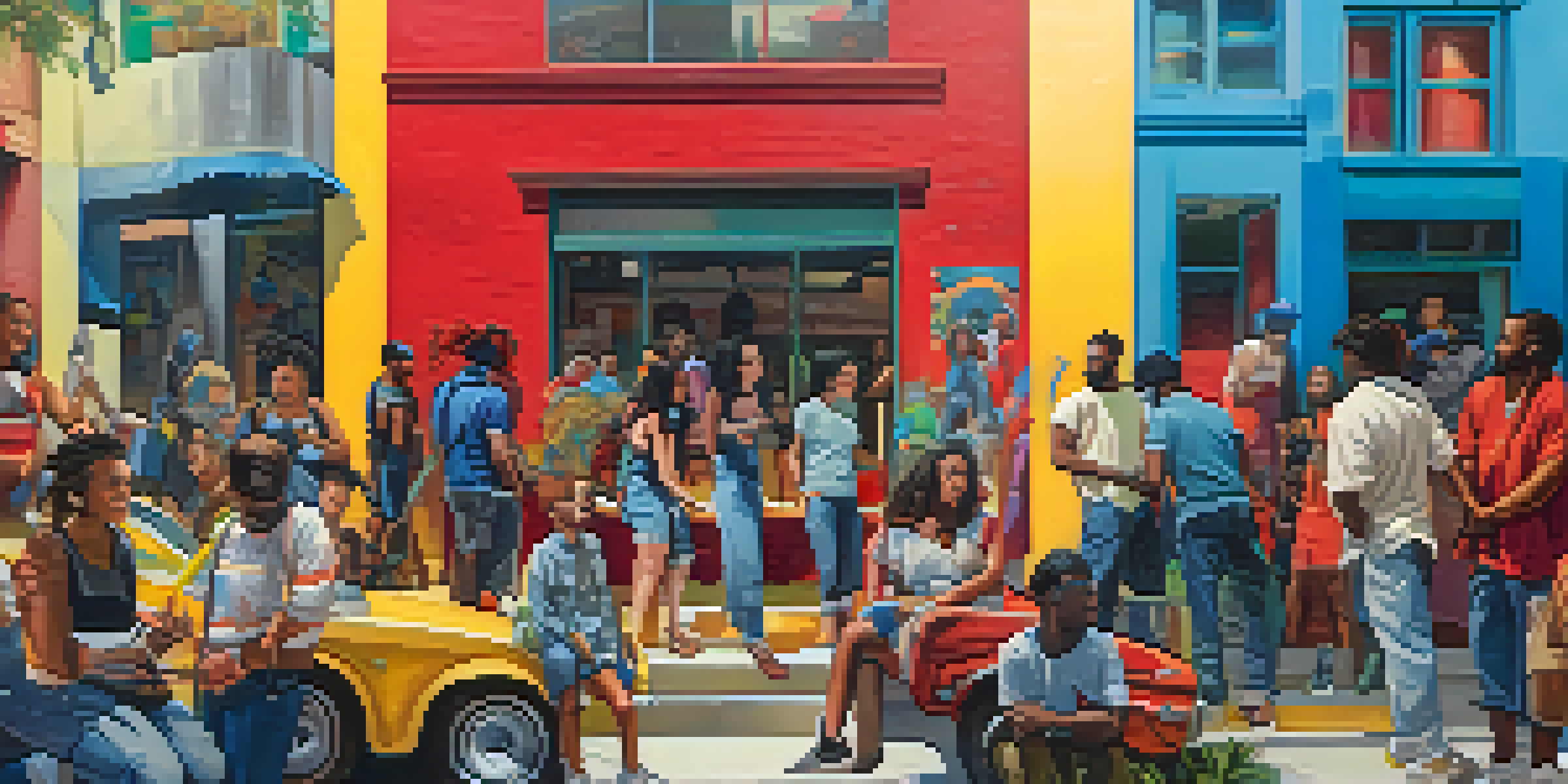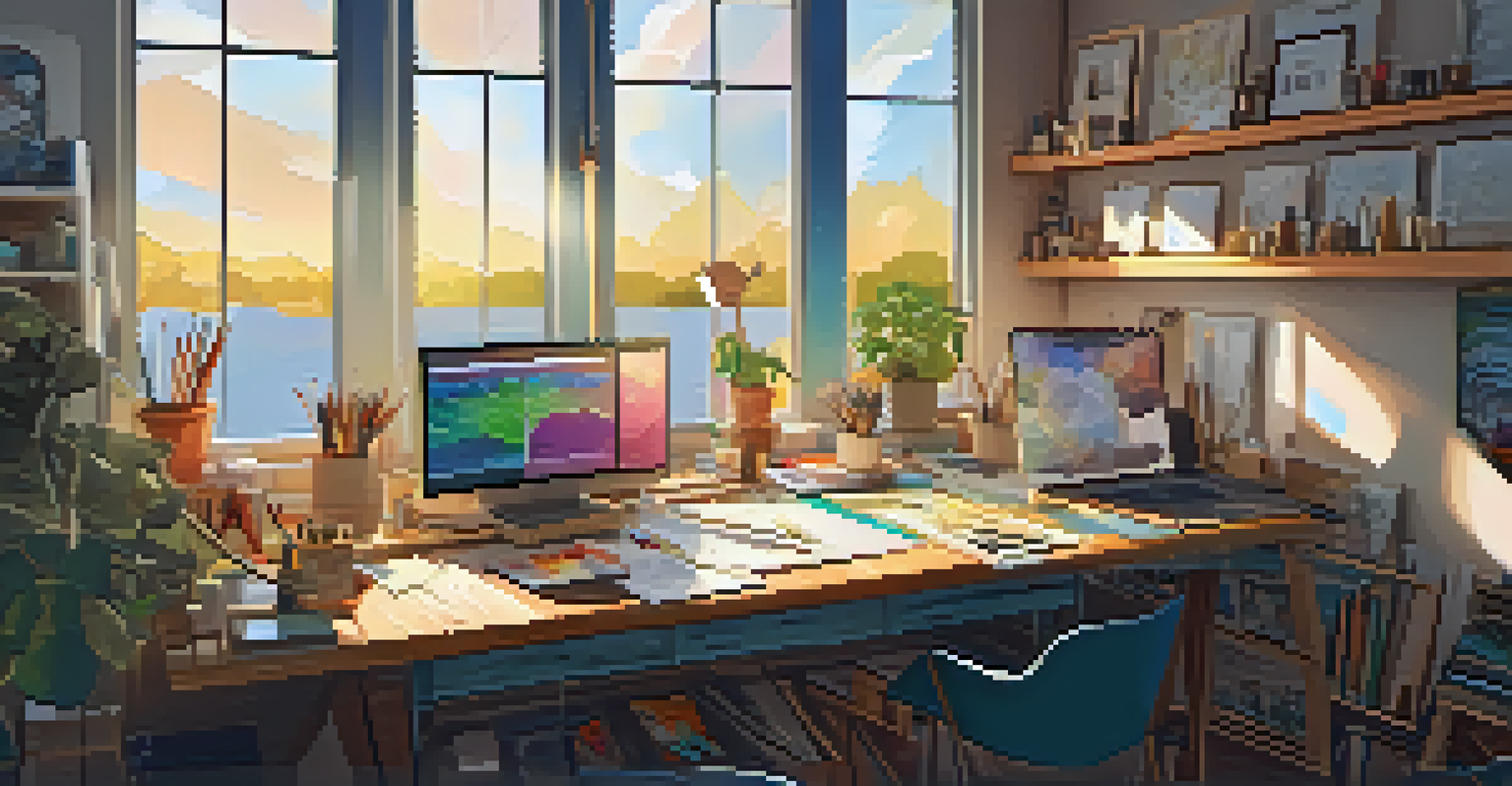Art Collectives: Redefining Artistic Collaboration

What Are Art Collectives and Their Purpose?
Art collectives are groups of artists who collaborate to create and promote art, often driven by shared goals or values. These collectives can take many forms, from informal gatherings of local artists to formal organizations with structured programs. The primary purpose is to foster creativity and innovation through collaboration, allowing members to combine their skills and perspectives.
Art is not a solitary endeavor; it thrives on collaboration and shared experiences.
By working together, artists can share resources, ideas, and networks, which can be particularly beneficial for emerging artists. This collective approach not only enhances individual creativity but also builds a sense of community and support among its members. For instance, a group of painters might collaborate on a mural that represents their neighborhood, bringing their unique styles together in a single piece.
In essence, art collectives challenge the traditional notion of the solitary artist, highlighting the power of collaboration in the creative process. They allow artists to experiment, take risks, and push boundaries, ultimately leading to innovative works that resonate on multiple levels.
The Evolution of Art Collectives Through History
Art collectives have a rich history, dating back to movements like the Impressionists, who often worked in groups to support each other's artistic endeavors. These early collaborations laid the groundwork for modern collectives, which continue to thrive today. Over time, various art movements have embraced the collective model, emphasizing community and shared vision.

For example, the Dada movement in the early 20th century was a reaction against conventional art, with artists collaborating to challenge societal norms. This spirit of rebellion found strength in numbers, allowing them to amplify their messages through performances, publications, and exhibitions. Such historical examples show that collaboration can be a powerful tool for artistic expression and social commentary.
Art Collectives Foster Collaboration
Art collectives bring artists together to share resources and ideas, enhancing creativity and building a supportive community.
Today, many contemporary art collectives draw inspiration from these historical precedents while also adapting to modern challenges. They often utilize technology and social media to reach wider audiences, creating a new landscape for artistic collaboration that transcends geographical boundaries.
How Art Collectives Foster Innovation
Art collectives are breeding grounds for innovation, as they encourage diverse perspectives and creative experimentation. When artists from different backgrounds come together, they bring unique ideas and approaches that can spark new concepts. This diversity often leads to the creation of groundbreaking works that might not emerge from an individual artist's practice.
The best way to predict the future is to create it together.
For instance, an art collective might host workshops or collaborative projects where members can explore unconventional materials or techniques. This hands-on approach not only nurtures individual growth but also strengthens the collective's overall artistic voice. Members often find themselves inspired by one another, pushing each other to think outside the box.
Moreover, the collaborative nature of these groups allows for real-time feedback and support, which can be invaluable in the creative process. This dynamic environment fosters a sense of shared ownership over the works produced, resulting in art that reflects a collective identity rather than just individual expressions.
The Role of Technology in Modern Art Collectives
Technology has revolutionized the way art collectives operate, providing new tools for collaboration and outreach. Online platforms and social media enable artists to connect with one another across the globe, forming virtual collectives that transcend physical limitations. This shift has made it easier for artists to share ideas, resources, and critiques without being restricted by location.
For example, many collectives now host virtual exhibitions, allowing members to showcase their work to a broader audience. These digital spaces can create a sense of community that fosters collaboration and engagement, even among artists who may never meet in person. As a result, the boundaries between local and global art scenes have blurred, opening up new possibilities for artistic expression.
Innovation Through Diverse Perspectives
By combining different backgrounds and approaches, art collectives spark innovative works that may not arise from individual practices.
Additionally, technology facilitates innovative practices, such as digital art and multimedia projects, that can be explored collaboratively. This integration of technology not only enhances the artistic process but also reflects the changing landscape of contemporary art, where traditional and digital mediums coexist.
Art Collectives as Agents of Social Change
Many art collectives position themselves as agents of social change, using their art to address pressing societal issues. By collaborating on projects that highlight social justice, environmental concerns, or cultural heritage, these collectives can amplify their messages and engage a wider audience. This activism often becomes a core part of their identity, inspiring members to create work that reflects their shared values.
For instance, collectives like the Guerrilla Girls use their art to confront sexism and racism in the art world, making powerful statements that challenge the status quo. Their collaborative efforts not only raise awareness but also inspire dialogue and action among viewers. Similarly, community-focused collectives often engage with local issues, creating art that resonates with their immediate environment.
Ultimately, art collectives harness the power of collaboration to enact change, proving that art can be a catalyst for social transformation. By working together, artists can create a collective impact that reaches far beyond what any individual could achieve alone.
Challenges Faced by Art Collectives
While art collectives offer numerous benefits, they also face unique challenges that can impact their effectiveness. One significant hurdle is the potential for conflicting visions and artistic differences among members. Balancing individual creativity with the collective's goals can sometimes lead to tension, requiring open communication and compromise to navigate.
Another challenge is securing funding and resources, which can be particularly difficult for emerging collectives. Without financial support, it can be hard to sustain projects or host events that foster collaboration. Many collectives rely on grants, donations, or crowdfunding, which can be unpredictable and require additional time and effort to manage.
Technology Transforms Art Collaboration
Modern technology enables art collectives to connect globally, facilitating virtual exhibitions and collaborative projects beyond physical boundaries.
Despite these challenges, many art collectives find ways to adapt and thrive. By fostering a strong sense of community and shared purpose, they can overcome obstacles and continue to create impactful work. The resilience of these groups speaks to the enduring power of collaboration in the art world.
The Future of Art Collectives
As the art world continues to evolve, so too do the structures and dynamics of art collectives. The increasing emphasis on collaboration, inclusivity, and social engagement suggests that collectives will play an essential role in shaping the future of art. Artists are likely to continue seeking out collective spaces that foster creativity and support their individual practices while addressing broader societal issues.
Moreover, the integration of technology will likely deepen, enabling collectives to expand their reach and impact. Virtual collaborations and online exhibitions will become even more common, allowing artists to engage with audiences and peers in innovative ways. This adaptability will be crucial as art collectives navigate the ever-changing landscape of the creative world.

Ultimately, the future of art collectives appears bright, driven by a shared commitment to collaboration and community. As these groups continue to redefine artistic collaboration, they will undoubtedly contribute to a more vibrant and inclusive art scene that reflects the diverse voices of contemporary society.